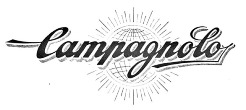|
|
| Category: | Rear Derailleurs |
| Name: | SunTour Grand-Prix (type 3) |
| Brand: | SunTour |
| Model: | 2300 |
| Years: | 1964 - 1970 |
| Country: | Japan |
| Weight: | 303 grams (avg)
View Weight List |
| Added By: | Catnap on 05/12/11 |
| Updated By: | peterbman on 05/09/18 |
Additional Photos - click for full size |
|
|
| Outer Plate Markings | SunTour Grand-Prix | Inner Plate Markings | MAEDA IRONWORKS LTD. JAPAN |
| Material | Steel | Design Category | Slant parallelogram |
| Attachment Bolt Size | | Cable Attachment Bolt Size | |
| Shifting Systems | Friction | Cable Adjuster | No |
| Cage Length | Short | Max Cog Size | 28 |
| Max Chain Wrap | | | |
The
Suntour Gran-Prix introduced the slant parallelogram to the world. It
is the most famous of the many brain-children of Nobuo Ozaki, SunTour’s
legendary chief designer. The idea is brilliantly simple - as the pulley
cage moves inwards, it also moves downwards, following the shape of the
freewheel and maintaining a reasonably constant chain gap. Virtually
every modern derailleur of any quality uses this design. The 1964 patent
on this design (US patent # 3,364,762) allowed SunTour to gradually dominate the derailleur industry, until it ran out in 1984.
The SunTour Gran-Prix was also notable in a number of other ways:
It
fits a Campagnolo hanger (and has an adjustment screw) - starting the
Japanese move away from Huret (SunTour’s original choice) and Simplex
(Shimano’s original preference). The hanger plate on this example is
particularly unusual with two holes for drop-out bolts - but it has the
tell-tale Campagnolo tag position. The
Gran-Prix is low-normal (‘Rapid Rise’ in Shimano-speak). And, in
addition, it uses SunTour’s unique single spring design - the same
spring operates the parallelogram and also tensions the chain. These
last two features are a touch too mad for my tastes - and I have never
found low normal gears to be very positive - whether they are the
ancient, cheapo, SunTour Skitter or the ultra-modern, fantastically
refined and expensive Shimano XTR. Text from: http://www.disraeligears.co.uk/Site/SunTour_Gran-Prix_derailleur.html |
| Quality: | | Rarity: | |
|
|
|
|
SunTour (Maeda)
SunTour derailleurs have a two-letter date code. On rear derailleurs the code is stamped on the back side of the inner parallel arm. On front derailleurs it is stamped on the back side of the inner cage.
The first letter represents the year. Larry Osborn and I believe O (Oh) is 1972, V is 1979 and A is 1984. As with Shimano, the second letter is the month code, where A is January and L is December.
SunTour Year Code
|
N |
O |
P |
Q |
R |
S |
T |
U |
V |
W |
X |
Y |
Z |
|
1971 |
1972 |
1973 |
1974 |
1975 |
1976 |
1977 |
1978 |
1979 |
1980 |
1981 |
1982 |
1983 |
| |
|
A |
B |
C |
D |
E |
F |
G |
H |
I |
|
|
|
|
|
1984 |
1985 |
1986 |
1987 |
1988 |
1989 |
1990 |
1991 |
1992 |
|
|
|
|
SunTour Month Code
|
A |
B |
C |
D |
E |
F |
G |
H |
I |
J |
K |
L |
|
Jan |
Feb |
Mar |
Apr |
May |
Jun |
Jul |
Aug |
Sep |
Oct |
Nov |
Dec |
The earliest Suntour derailleur I have found with a code is marked OF. A rear derailleur marked OD (corresponding to April of 72) was reported by Leighton Walter. I have a bike that dates from between 1970 to 1972 that has the original SunTour derailleurs. These derailleurs do not have date codes on them, so I believe the coding started sometime between 1970 and April of 1972.
(source: vintage-trek.com)
